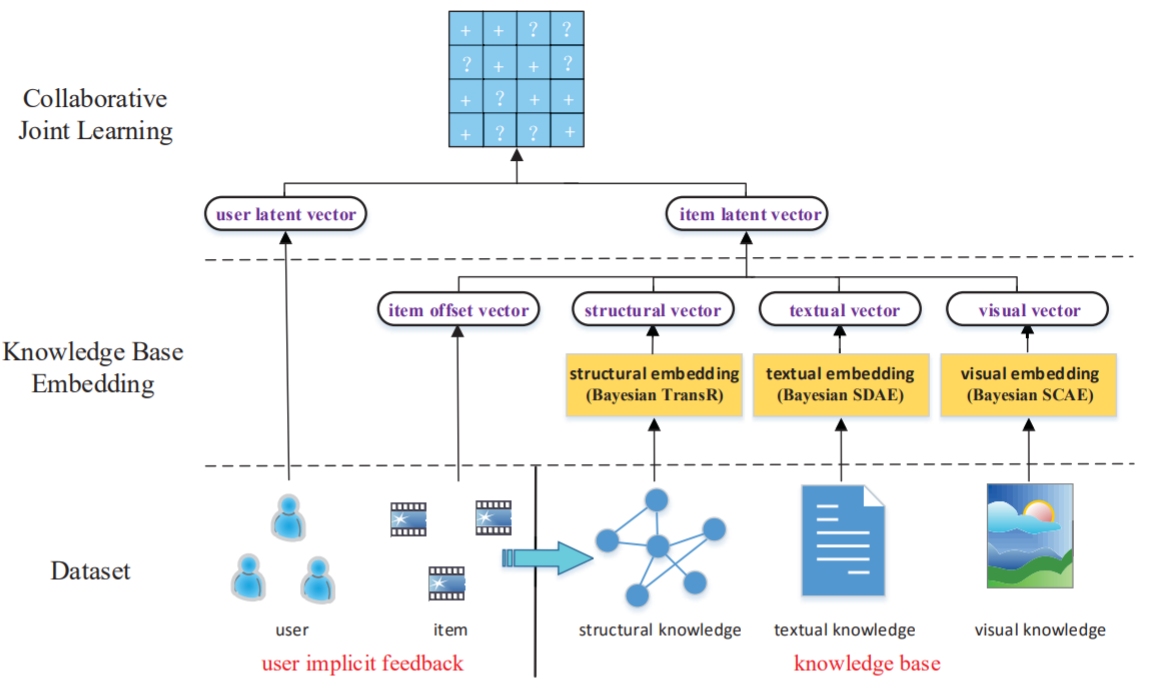CKE¶
Introduction¶
Title: Collaborative Knowledge Base Embedding for Recommender Systems
Authors: Fuzheng Zhang, Nicholas Jing Yuan, Defu Lian, Xing Xie, Wei-Ying Ma
Abstract: Among different recommendation techniques, collaborative filtering usually suffer from limited performance due to the sparsity of user-item interactions. To address the issues, auxiliary information is usually used to boost the performance. Due to the rapid collection of information on the web, the knowledge base provides heterogeneous information including both structured and unstructured data with different semantics, which can be consumed by various applications. In this paper, we investigate how to leverage the heterogeneous information in a knowledge base to improve the quality of recommender systems. First, by exploiting the knowledge base, we design three components to extract items’ semantic representations from structural content, textual content and visual content, respectively. To be specific, we adopt a heterogeneous network embedding method, termed as TransR, to extract items’ structural representations by considering the heterogeneity of both nodes and relationships. We apply stacked denoising auto-encoders and stacked convolutional auto-encoders, which are two types of deep learning based embedding techniques, to extract items’ textual representations and visual representations, respectively. Finally, we propose our final integrated framework, which is termed as Collaborative Knowledge Base Embedding (CKE), to jointly learn the latent representations in collaborative filtering as well as items’ semantic representations from the knowledge base. To evaluate the performance of each embedding component as well as the whole system, we conduct extensive experiments with two realworld datasets from different scenarios. The results reveal that our approaches outperform several widely adopted state-of-the-art recommendation methods.

Running with RecBole¶
Model Hyper-Parameters:
embedding_size (int): The embedding size of users, items and entities. Defaults to64.kg_embedding_size (int): The embedding size of relations in knowledge graph. Defaults to64.reg_weights (list of float): The L2 regularization weights, there are two values, the former is for user and item embedding regularization and the latter is for entity and relation embedding regularization. Defaults to[1e-02,1e-02]
A Running Example:
Write the following code to a python file, such as run.py
from recbole.quick_start import run_recbole
run_recbole(model='CKE', dataset='ml-100k')
And then:
python run.py
Tuning Hyper Parameters¶
If you want to use HyperTuning to tune hyper parameters of this model, you can copy the following settings and name it as hyper.test.
learning_rate choice [0.01,0.005,0.001,0.0005,0.0001]
kg_embedding_size choice [16,32,64,128]
reg_weights choice ['[0.1,0.1]','[0.01,0.01]','[0.001,0.001]']
Note that we just provide these hyper parameter ranges for reference only, and we can not guarantee that they are the optimal range of this model.
Then, with the source code of RecBole (you can download it from GitHub), you can run the run_hyper.py to tuning:
python run_hyper.py --model=[model_name] --dataset=[dataset_name] --config_files=[config_files_path] --params_file=hyper.test
For more details about Parameter Tuning, refer to Parameter Tuning.
If you want to change parameters, dataset or evaluation settings, take a look at